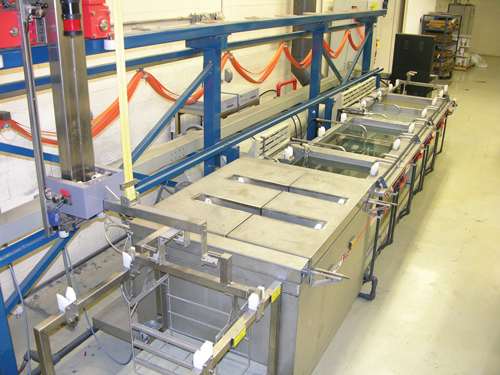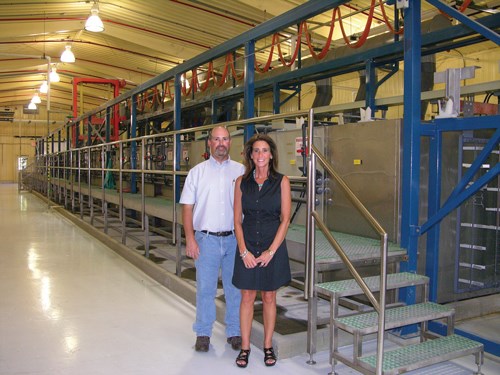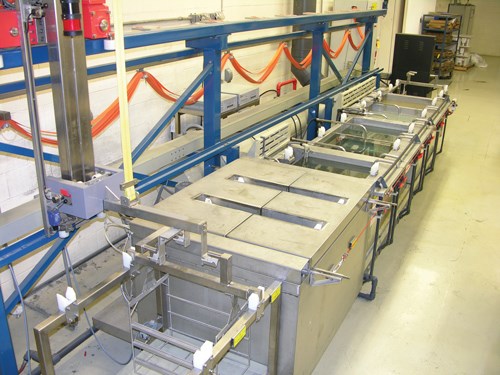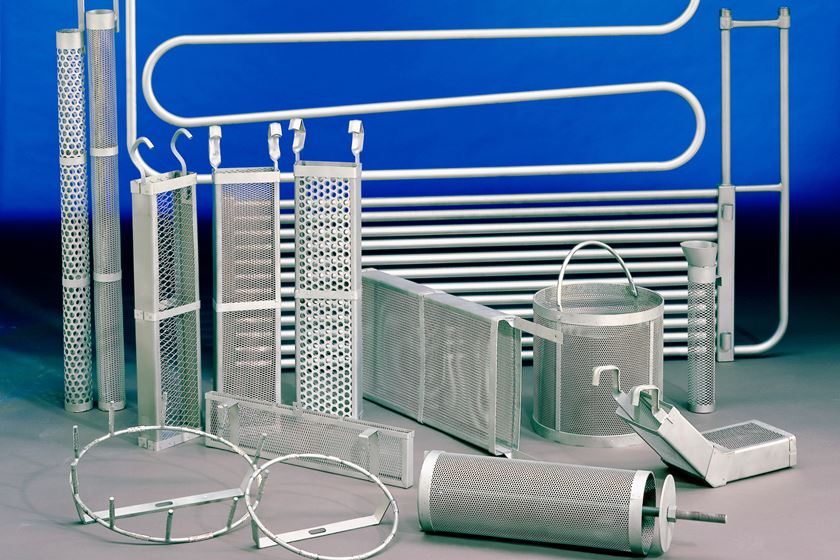Medical Coatings Find a Home in Indiana
Warsaw is home to a diverse and exceptionally local community of Tier 1s and specialty services providers, including Whimet Inc., a prominent, second-generation provider of anodizing and ultrasonic processing,
#medical
Nearly two thirds of the world’s orthopedic product manufacturers, including the medical industry’s dominant names, are located in Warsaw, Ind.
Featured Content
Supporting those orthopedic manufacturers is a diverse and exceptionally local community of Tier 1s and specialty services providers, including Whimet Inc., a prominent, second-generation provider of anodizing and ultrasonic processing, both of which are critical for proper performance of the medical implants that restore mobility to more than one million Americans each year.
Implants have an intimate impact on human patients, and what is required of orthopedic device companies and their supplier families is unrivaled in terms of quality, reproducibility and documentation.
President Lori Whitehead and Vice President Chad Whitehead comprise Whimet’s senior leadership team. Lori’s earliest memory of the business was a discussion with her dad, founder Murvel Whitehead, in about 1973 as he hand-polished a hip replacement component and explained how it would work.
“The implant industry as it is known today was in its infancy,” Lori says.
From Mowers and Boats
Founded in 1970, Whimet began by offering polishing, buffing and deburring to a customer base that included manufacturers of medical devices, as well as furniture, telecommunications devices, lawn mowers and boats.
“All operations were manual,” Chad says.
In the years that followed, Whimet added passivation, anodizing, ultrasonic cleaning, electropolishing, vibratory finishing, three types of abrasive blasting and laser etching to its stable of services, while also opening a second location to accommodate all of its post-treatment services.
In 2007, the company was awarded its first ISO 9001 certification, and it currently is certified to ISO 9001:2008.
Lori and Chad Whitehead took over the helm of the company in early 2007 and learned that if the company was to continue to grow, additional processing capacity and significant automation would be needed.
“The first goal was to consolidate operations into a single large facility, thus streamlining handling and transport,” Lori says. “The second immediate need was to identify an equipment supplier for its first automated line.”
Lori spent the first 15 years of her career on the East Coast, selling enterprise resource planning software systems and later software implementation services before deciding to move back to Indiana to work with Chad, who had managed Whimet operations for more than a decade.
New Facility and Equipment
Together, they waded into the complex tasks of facility design and finding an equipment supplier who was best qualified to design and manufacture a line for one of the company’s most critical processes: anodizing.
At the time the new line was being discussed, Whimet was doing black and clear anodizing. The management team worked with production workers and major customers to establish some broad requirements for the new system.
“We had a reputation for very high consistency of results,” Lori says. “We needed to maintain that high standard while also gaining the ability to do additional colors in-line. We wanted the ability to process higher volumes efficiently, yet most of our work involves highly specialized volumes—sometimes as few as one piece. So we needed a system that was extremely agile and cost-efficient to operate, regardless of the parts volume.”
The team talked with numerous suppliers of equipment and chemistry, and tentatively decided to work with Walgren Co. of Grand Rapids, Mich., a leading supplier of systems for all anodizing types, including chromic acid, sulfuric acid, hardcoat, phosphoric acid and boric sulfuric, and titanium anodizing.
Strong Plating Reputation
Walgren also had a strong reputation for plating and electrocoating systems, and for the design of cost-efficient environmental management systems.
“We arranged visits to see two of their lines, and what we learned from those customers essentially confirmed what we had been told,” says Chad, who commissioned Walgren to build the Whimet line and, since the new facility was being built simultaneously, to assist with building specs that would optimize the line’s efficiency.
The anodize line Walgren built has 27 stations. There are two fixed load and unload stations, and 26 tanks, each 54 × 64 inches deep with varying widths. Anodize chemistry tanks are 1-inch polypropylene; tanks for cleaner, rinses, sealer, dye, etch and passivate are 10-gauge 304 or 316 stainless steel.
The system’s two 1,500-lb. capacity programmed hoists are each equipped with a variable-speed transfer motor that moves up to 200 fpm and a variable-speed lift motor that moves up to 95 fpm. The hoists were supplied with floor-mounted superstructures and umbilical cables for power and control wiring. The system is controlled by a Windows-based computer, and a PLC controls hoist movements.
Three Operating Modes
Through the interface, the operator selects among three operating modes: automatic, where the PLC controls all hoist activity; semi-automatic, where the operator can send a hoist to a selected station; and manual, where the operator controls vertical and horizontal motion using arrows on a keypad.
A catwalk remote panel, located at the line’s midpoint, enables the operator to switch between modes and control the hoist from the catwalk.
Process steps include nickel seal, three dye options (black, gold and a variable third alternative), etch, desmut, stainless steel passivate and anodize.
The line is served by three rectifiers rated at 3,000 amps at 24 volts. Refrigeration to maintain 70oF +2oF in the anodize tanks is provided by a system that includes a packaged air-cooled chiller, compressors, chilled water circulation pumps and frame-type heat exchangers. Fumes are exhausted by a 30,000-cfm ventilation system.
Turnkey Responsibility
Walgren had turnkey responsibility for engineering and manufacturing the Whimet system. When all modules were complete, the system was set-up in Walgren’s Grand Rapids manufacturing facility where “full fit and function were evaluated in detail,” according to Chad Whitehead.
Walgren worked with Whimet’s utility construction contractor on the installation and assisted with the two-week setup, providing start-up support and commissioning.
“The value of the system was clear from the start,” Chad says.
“We can now very competitively anodize the broadest range of medical and non-medical components, while maintaining the highest quality levels and lead times that we know are the shortest in the industry,” he says. “What was equally significant, though, was what we learned from this process and the many ways we benefited from not ‘over-writing’ our specifications.”
Those insights were put to work again three years after the anodizing line was installed when Whimet wanted greater capacity and greater automation from its ultrasonic cleaning operation.
“Once again, the goal was to keep variability out of the process,” Chad says. “So we went to the equipment company we knew could do the work and added ultrasonics, rather than having an ultrasonic company put equipment around their technology.”
Six Stages, 30 Minutes
The ultrasonic cleaning system engineered by Walgren is six stages and takes about 30 minutes to complete. It includes a hot deionized water rinse, an ultrasonic and conventional rinse, ultrasonic cleaning, alkaline soak clean with eductors, and drying. The immersible ultrasonic transducers are high-efficiency piezoelectric drivers housed in stainless steel enclosures.
A unique control device developed by Walgren exclusively for hoist operations was an important part of the plan. The Process Control Enhancer simplifies program entry and modification through a keyboard that has clear, simple commands in true “catwalk” language: up, down, forward, reverse, etc. Multiple users can view the system live.
“With anodizing, we relied on a company that had built those lines many times before, and, as a result, we benefitted from Walgren’s judgments about a hundred or more factors we could never have known about,” Chad says. “Cooling coils, rack carts, tank saddles, load and unload positioning—they knew the performance margins and the safety factors for each because that is what they are about.”
Chad says both the anodize line and the ultrasonic cleaning line are on track to meet their respective five-year ROI targets y early this year.
Information in this story provided by Walgren Co. For information on Whitmet, please visit Whimetinc.com. For information on Walgren Co., please visit Walgren.com
Price Walgren
RELATED CONTENT
-
Deoxidizing Aluminum as a Pretreatment
This important first step can help prepare the metal for subsequent surface finishing.
-
Anodizing for Bonding Applications in Aerospace
Anodizing for pre-prep bonding bridges the gap between metallic and composite worlds, as it provides a superior surface in many applications on aluminum components for bonding to these composites.
-
Test Methods For Evaluating Anodized Aluminum
Benefits of anodizing include durability, color stability, ease of maintenance, aesthetics, cost of initial finish and the fact that it is a safe and healthy process. Maximizing these benefits to produce a high–performance aluminum finish can be accomplished by incorporating test procedures in the manufacturing process.





















